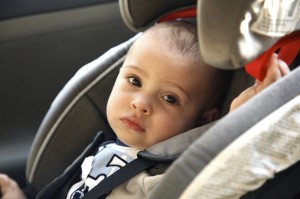
Many Parents Position Newborns Wrong or Install Baby Car Seat Incorrectly for Baby’s First Ride Home from Hospital
Some parents may not think about it, but one of the things expecting parents ought to do before their little one is born, is to learn the proper techniques for placing the newborn in the car safety seat they’ll use, as well as installing the safety seat correctly.
According to a recent small study, the far majority of parents make one or more big mistakes when they place the infant in the seat or in installing the seat, as they drive home from the hospital with their newborns.
Researchers at Oregon Health and Science University Hospital studied 267 randomly selected mother-infant pairs from the hospital’s maternity unit; they found that 93 percent of caregivers made at least one critical mistake in how they positioned the infant, or how they installed the car seat. A critical mistake is defined by the National Highway Traffic Safety Administration as one that puts a baby at increased risk for injury in a crash.
The study’s name was “Unsafe from the Start: Critical Misuse of Car Safety Seats for Newborns at Initial Hospital Discharge;” it was an appropriate title, given that a lot of important mistakes were seen. A certified child passenger safety technician observed how new mothers or designees placed the infants in the car safety seats, and how the seats were placed in the vehicle in which the family would drive home from the hospital. The technician recorded misuses, based on car safety seat and vehicle manufacturer guidelines. (Technicians helped caregivers correct all the mistakes before the infants were driven home.)
Results
The most common mistake in positioning newborns, made by 69 percent of the caregivers observed, was the safety seat harness being too loose; the retainer clip being too low, 34 percent; use of a product not approved for the seat being used, 20 percent; the harness being too high, 18 percent; and not knowing how to adjust harness, 15 percent.
The most common safety seat installation mistakes were safety seats installed too loosely, 43 percent; incorrect angle of safety seat, 36 percent; safety belt used but not locked, 23 percent; and incorrect amount of space between safety seat and vehicle front seat, 17 percent.
Families who had consulted with a certified car seat technician before their baby’s birth were 13 times more likely to place their babies correctly and install the car seats correctly.
Study author Dr. Benjamin Hoffman, of Doernbecher Children’s Hospital in Portland, OR, underlined that it is important to provide families with the resources and services necessary to help ensure safer travel for newborns and all children. He pointed out that car crashes kill more young children in the United States than any other cause.
Results of the study were presented recently at the American Academy of Pediatrics annual meeting, in San Diego, CA.
By Lisa Pecos